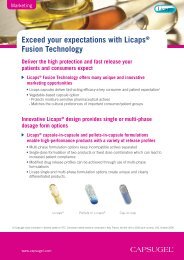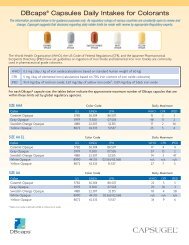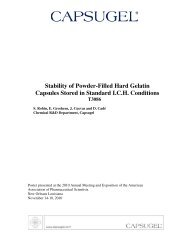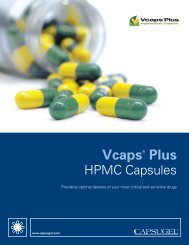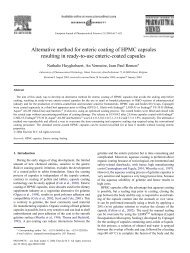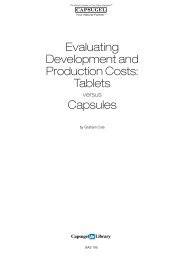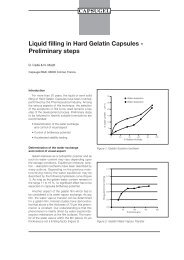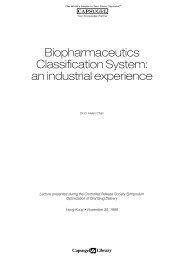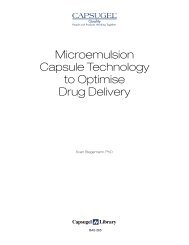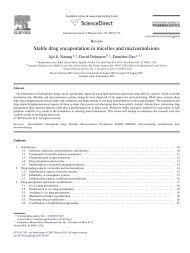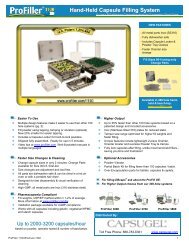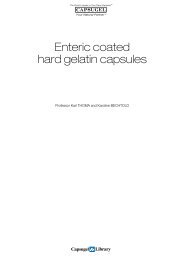Beyond Fast Filling - Capsugel
Beyond Fast Filling - Capsugel
Beyond Fast Filling - Capsugel
- No tags were found...
Create successful ePaper yourself
Turn your PDF publications into a flip-book with our unique Google optimized e-Paper software.
ICT<strong>Beyond</strong> <strong>Fast</strong> <strong>Filling</strong>The strategy of powder-in-capsule has the ability to accelerate the clinical developmentcycle. David Edwards of <strong>Capsugel</strong> investigates new developments on the drug marketDavid Edwards is Director of Pharmaceutical Technology at <strong>Capsugel</strong>, a division of Pfizer, andis globally responsible for the commercialisation of <strong>Capsugel</strong>’s pharmaceutical equipment.David has worked in the pharmaceutical industry for over 30 years, holding a number of seniorpositions in Meridica (a start-up drug delivery technology company), which was successfullysold to Pfizer in 2004; PA Consulting; Roche; and Nicholas Laboratories. He started his careeras a Laboratory Microbiologist with Oxoid Ltd. A graduate with degrees in Microbiology andBusiness Studies, David is based in Cambridge, UK.The early stage is a critical time during the development life cycle of a new drug.Like a newly hatched tadpole, it has to compete for resources, not only with itstadpole siblings, but with all the others sharing the pond in order to survive. Nomatter how large it is, the parent drug company has to choose which of its newlyhatched drug candidates are best suited to survive and grow in the marketplace,and then direct available resources accordingly.TIME IS MONEYThere are many resource constraints in early stage drugdevelopment, such as available drug quantities, testingpersonnel, equipment, funding and, perhaps most crucially,time. With a patent life of 20 years and a developmenttimescale of 10-12 years, the window of opportunity for adrug is limited and it is imperative that the drug has enoughtime on the market to recoup investment and to beprofitable in line with the company’s needs. Any legitimatereduction in the development process can result in anextension of the profit window for the drug. Consequently,such shortcuts are avidly sought by R&D departments.With this in mind, let’s focus on one of the first key ‘go/nogo’decision points for the new molecular entity (NME)drug candidate for many pharma companies – Phase Iclinical trials, or ‘First in Human’ studies. Phase I includesthe initial introduction of an investigational new drug intohumans. These studies are closely monitored and usuallyconducted in healthy volunteer subjects, with a focus onsafety. They are also often designed to better clarify thepharmacokinetic and metabolic properties of the drug.During Phase I, sufficient information should be obtainedto permit the design of well-controlled, scientifically valid,Phase II studies.The first-in-human hurdle is important for a number ofreasons; it gives a first indication of tolerance andprospective efficacy in humans and, because trialparticipant numbers are typically small, the cost isrelatively low. This means that a number of candidatecompounds can be assessed for comparative viabilitywithout committing excessive financial resources. Thefaster this can be done, the faster less viable candidates canbe eliminated, so the concept of ‘faster-time-to-first-inhuman’can also be construed as the rather negativesounding ‘faster-time-to-fail’. Knowing that a compoundwill not make it any further to market will release precioustime and other resources in order to concentrate on otherNMEs that have potential, and will also reduce the risk offailure at much later and far more expensive stages of theclinical development process.HISTORICAL CHALLENGES OF MICRO-FILLINGMuch work has been done by pharma companies to speedup or improve R&D processes in order to reduce timescales,and real savings can be achieved with the use of newtechnologies. One, which has come to the fore over the lastfew years, involves dosing pure drug or activepharmaceutical ingredient (API) rather than formulated orblended product for production of Phase I clinical trialmaterials (CTM).In the past, this strategy was employed rarely, primarilybecause of the difficult controls required to manuallydispense many individual low dose weights. This had aInternational Clinical Trials Spring 2008 issue. © Samedan Ltd. 2008
MeshFigure 1: Building and breaking of micro-bridgesPowder runsthroughaperturesPowder buildsmicro-bridgesImpactMicro-bridgesbreak downon impactMicro-bridgesrebuildAnother complication involves the container for thedrug; the method of drug-in-bottle (aka powder inbottle) was, and still is, commonly used. This involvesdispensing the drug, again by hand, into a suitablebottle, dissolving or suspending it in a vehicle such aswater or methylcellulose, and administering it to the trialparticipant. This too has inherent problems, in additionto weight control, the ability to re-suspend and elute theentire drug is not easy and therefore can often beunpalatable.LINKING SCIENCE TO SIMPLE PRINCIPLESolenoidFigure 2: Weight control systemTapper armThe advent of new dosing technologies, such as theXcelodose system, has revolutionised this process. Thetechnology involves the precise dosing of drug powderinto capsules and other small dose containers bygravimetric means.ComputerCapsuleThe technology makes the powder behave like aliquid, flowing through a mesh within a hopper ordispense head that promotes powder ‘micro-bridges.’These micro-bridges break and reform if a shock ortapping action is applied to the outside of the hopper(see Figure 1).Balancenumber of limitations, not least the sheer repetitiveness andensuing error potential of a manual process which isextremely labour intensive. Weights below 10-20mg couldnot be reliably filled by hand with any accuracy orprecision, and the losses were likely to be high. Often, withlimitations on the amount of drug available, drugdevelopers would blend or formulate drug product so thatoverall drug weights were easier to manipulate. Thedownside of this was that the resulting formulated productwould require stability and homogeneity testing over aperiod of three to six months, thereby adding more time tothe process.Figure 3: Dispense head componentsBodyMeshTipOn breaking the micro-bridge, a small amount of drugpowder passes through the mesh and into a container. Theaction is similar to that employed in a pepper pot orpepper shaker. The amount that passes is remarkablyconsistent and is a function of the number of holes in themesh, the diameter of the holes and the powdercharacteristics. The weight dispensed is controlled by aseven-place micro-balance, linked to a computer, whichcontrols the amount of tapping when facilitated by a solenoid(see Figure 2).The weight of each capsule is tared to zero, enabling thesystem to weigh and record API weight, with doses as lowas 100mcg easily achievable for many powders. Themachine uses a supervisory PC control algorithm tocontinuously monitor the weight being dispensed in realtimeby adjusting the parameters that influence the flowrate. The amount of powder falling as a result of each tapbeing measured approximately 15-20 times persecond. This enables the system to ‘learn’ how thepowder behaves. By setting the machine to a targetweight, together with pass/fail limits, the numberof taps is controlled as the system adjusts accordingly.This will take into account whether the powder is freeflowing, of even particle size, or if it comes out in lumpsof uneven particle size. The tapping rhythm is initiallyapplied at a fast rate to reach approximately 80 per centof the target weight, and then switches to a slower rate toachieve precision of fill. Using this methodology,the system can easily achieve relative standarddeviations (RSDs) of product weights below two percent for most powders.
WORKING WITH MATERIALSOF VARYING PROPERTIESDispensing powders with differentcharacteristics (for example, fluffy,cohesive, free flowing, micronised,and so on) is accomplished using anumber of techniques, and industryfeedback seems to indicate that, todate, provided a powder can bemade to form micro-bridges, it canbe dispensed using this technology,irrespective of particle size. This isaccomplished by the availability ofa wide range of dispense heads –see Figure 3.Figure 4: Baffles for usewith cohesive powdersThese heads differ with variantsfeaturing small numbers of largeholes or large numbers of small holes, varying body shapesand tips to best accommodate dispensing of the powder and thespecific weight required. Dispenser heads with larger holes areusually used to dispense larger weights, with the converse alsoapplying. Ideally, the dispensing time should be in the order of5-10 seconds.The technology can also be ‘tailored’ to the powder inorder to give higher throughput or greater precision. Hereagain, additional techniques can be employed: speeding up orslowing down the rate of tapping; increasing/decreasing theforce of the tap; and applying the use of baffles or stainlesssteel rods inserted into the powder within the dispense headto break up cohesive or sticky powders (see Figure 4, page38). Beads and granules can also be filled using the system.Using these techniques, the system can accurately andprecisely fill weights within the range of 100mcg to severalhundred milligrams. It does not employ a tamping mechanism,and consequently the actual amount of powder that will fit intoa capsule is limited by the powder’s physical characteristics. Asthe powder is tapped into the capsule, larger particle sizes falland will be surrounded by considerable air space. In somecases, the drug substance may require pre-processing toincrease density and enable high dose powder-in-capsule (PIC)formulations. Roller compaction followed by milling has beenused in such applications (1).FASTER FILLING: USING LESS APIIN EARLY DEVELOPMENTWith its ability to dispense such small weights with accuracyand precision, the technology supports a material-sparingformulation approach, which enables scientists to decreasethe time required for dosage form development by placingthe drug substance into a capsule. Powder-in-capsule (PIC)reduces development time, conserves drug substance andallows better management of resources against compoundattrition (2).Blended or formulated product has also been successfullydispensed using this kind of technology. There are somelimitations, but trials have shown that if the powderconstituents are of approximately equal size, then thepotential for segregation is minimised (3).One model that has been developed is fully automated and isdedicated to filling capsules, both gelatin and HMPC, in awide range of sizes (00-4). The use of capsules in Phase Istudies is very commonplace, as these offer a convenientdose form which is both easy for the formulator tomanipulate, and easy to swallow for the trial participant.The system is completely automated in taking emptycapsules, rectifying them into the correct orientation,separating the top from the bottom by the application of avacuum, and filling into the base of the capsule, which has
een tared to zero on the balance pan. The filled capsule isthen moved around on a carousel, re-united with its top,checked for length and sorted into accept (‘good’receptacle) or fail (‘bad’ receptacle). The capsule can bedeemed as a failure for a number of reasons, including:weights fall outside the limits set by the operator; capsuledoes not close properly; or the capsule is or is not present inits entirety.This higher throughput system is largely dedicated to themanufacture of CTM samples, but has also been used forformulation development. Capsules are readily available invarious sizes to accommodate differing doses and also aremore patient-friendly by being easy to swallow and mask thetaste of the active. Opaque capsules can be used to blind theformulation if desired.By comparison, the second model features the same fillingtechnology but is semi-automated – that is, the user loadsthe containers into the machine manually and removesthem at the end of the fill. The advantage of thismachine is its flexibility; it can be adapted to fill othercontainers as well as capsules. To date, the system has beenused for filling cassettes for needle-free injection units andblisters for inhalation products. Other applications includevials and tubes.Documentation and traceabilityof data is crucial for all CTMbatches. This technology weighsand records the data for eachcapsule, including amountand time of fill, associatedbatch and run records, andany operator interventionduring the run.the development process, particularly for Phase I trials. Thetechnology is becoming widespread in its use throughout theindustry, with many companies of all sizes (from smallbiotech to large pharma) using the technology for early stagestudies. With the aforementioned extended downstreambenefits, the concept of micro-filling can be expected tocontinue to grow, as it helps enable pharma R&Ddepartments to remove the ‘losers’ and pick the ‘winners’ atan earlier stage, thereby giving the fittest tadpoles thechance to turn into fully grown frogs! ◆Documentation and traceability of data is crucial for allCTM batches. This technology weighs and records the datafor each capsule, including amount and time of fill,associated batch and run records, and any operatorintervention during the run. The system records data forboth ‘within specification’ capsules and ‘outside ofspecification’ capsules. The two groups are dispensed intoseparate containment units in the machine during use. Therun records are produced in PDF format using asoftware system which is 21 CFR part 11 compliant,and which will allocate an electronic signature that isindividual to each machine. Data is input via a humanmachineinterface (HMI), which is also used to control thefunctions of the machine. This unit is separated from themain dispensing unit by three meters of umbilical cable,which also allows the dispensing unit to be housed in acontainment system, isolator or different class of airhandling if so desired.CONCLUSIONThe novel concept of dosing pure APIs, making PIC dosinga viable strategy for clinical trials, offers real-time savings inThe author can be contacted atdavid.edwards2@pfizer.comReferences1. Mouro D, Noack R, Musico B, King Hand Shah U, Enhancement of Xcelodose TMCapsule-filling Capabilities using RollerCompaction, Pharmaceutical Technology,3rd Nov 20052. Canter K, Millheim A, Mouro D, Noack Rand Perry L, Characterisation and Optimisationof Powder in Capsule Technology, Journal ofPharmacy and Pharmacology Vol 59, Suppl 1,p16, September 20073. Fagan PG, Hood MR and Woolven H, AnAssessment of the Suitability of the Xcelodose600 in the filling of blended products, AAPSProceedings 2006




